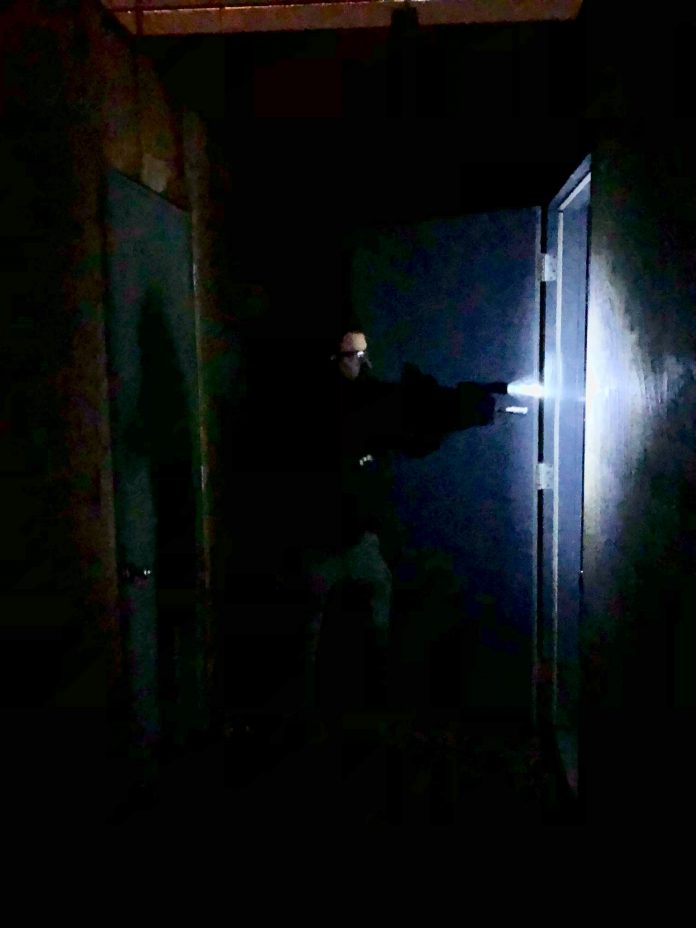
IWI Academy’s Tavor Operator III, an exceptional and chilly (not chilling) conclusion to this training saga.

This review dedicated to the memory of Tom Alibrando… He’s fine, I talked with him just a moment ago and confirmed my X95 SBR order, but this looked too much like a touching tribute photo stuck to the barricade to pass the opportunity. Photo Credit – Adam L.
Tavor III
Part 3 of the Tavor/X95 operator series is all on the gun. No more powerpoint. No more of the “why are you here… here is the outline”. We all knew why, having done it at least twice before, time to run out the X95 like it was born to run.

Plenty of snow and just above freezing to give us a nice soupy mess to play in.

Tavor I establishes what the Tavor/X95 is and sets you up with foundational fundamentals.
Tavor II is the honing of those fundamentals into competence. As the shooter you shouldn’t be mystified or searching for a control on your rifle anymore.
Tavor III brings it all in with individual tactics application, extreme conditional problem solving, and darkness/low light shooting.

Magazines jammed with Double Tap 55gr, I would be sending a full case of 1,000 rounds of this down range through the cold and wet. No ammunition failures, clean and accurate, perfect for the course.
Day 1, Morning

A shotgun blast rehash of Tavor II with a reshoot of the qualifier. In total about 200-300 rounds warming up our bodies to working in the cold and wet, especially with gloves. The last time most of us were on these guns for this many rounds… it was warmer.

There’s nothing like the satisfaction of training paying off and seeing measurable improvements. My score on that fine sunny day was passable, adequate to advance to the next course, but on this cold wet Saturday I had improved to 4 points shy of a clean 300.
Training
Works
Folks
Get on the list.
Day 1, Afternoon

After lunch we hit the shoot house.
Individual room clearing tactics.
The full Tavor X95 program is a fighting gun program designed from an individual end user standpoint.
The whole curriculum is set up around the idea that when something goes bump in the night you grab your carbine and take care of defending you and your family as safely and efficiently as possible.
Squad tactics are really really cool! Believe me, I’ve run every position of a squad through dry and live drills. But you (and I) don’t need squad tactics here, we’re individuals in a defensive combat space. Honestly team tactics get pretty easy if you know your individual stuff anyway.

Room clearing is always a tactical gamble.
Room clearing by yourself is the most dangerous version of that gamble.
When you clear with a team or a squad you own the space you take and you have someone standing by with a weapon in case the bad guy(s) try and take it back. When you clear alone… it’s just you.
Moving on your own, every room you leave is surrendered territory unless there is no way to get around you. There will be a point where you cross into space where someone can move and get behind you. The further you move the more likely that is.
Do I have to move from where I am at?
Yes: Spouse/Kids are in the another room and I need to get to them, weapon is in another location, there are too many entrances to this room to cover safely.
No: Everyone is here, I have the door covered, police are on the way and I told them the room I am in.
Progressing beyond running the rifle and thinking about the whole fight.
Day 1, Night

Oh yes, room clearing in the dark.
The amount that visual sensory deprivation (you can’t see) makes you focus is astounding. Add to that tactile sensory deprivation (cold, gloves) and the amount you slow down and zero on what you can see, feel, and hear actually improved our shooting. We weren’t cocky anymore.
Shooting at night is something you need to train every now and then. You need to learn how to properly work a light, preferably from either shoulder and with either hand (the Tavor/X95 makes that pretty easy actually)
Knowing the limits of your equipment and what your asking it to do is just as important. Is the Streamlight TLR-7 I had on my X95 good for 50 meters? 100? 150?
A better question is what can your light do? Don’t have one? Fix that.
Day 2, Morning

It works in the daylight, it works in the dark. Does it work at odd angles?

Working through several variations of awkward shooting position for different situations there are two key takeaways.
First, remember that gravity is a constant but your gun was designed to be fired from a vertical orientation and arc the bullet parabolically.
Second, these are ‘tool box’ positions for disadvantaged situations.



After working odd angles the final lessons were on one handed shooting and manipulations. Literally the worst of the worst case scenarios: being limited to one arm and clearing a double feed. Doable, just a pain… and it beats losing a gunfight.

Final Quiz Time
What’s on your training calendar for 2019?
Seriously, quality training is the best money you can spend in the gun industry. You’re never going to get to shoot more rounds, in a wider variety of ways, and with some people who are going to become the best to know.
All the analytics of why you should take a course aside, there’s a reason beneath the practical.
It’s the most fun I’ve ever had shooting. No contest, every dime and minute of time spent getting to these courses has been the greatest investment, beating every optic, rifle, or handgun I’ve ever purchased. Nothing surpasses running the guns like they were meant to run.



